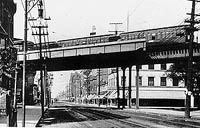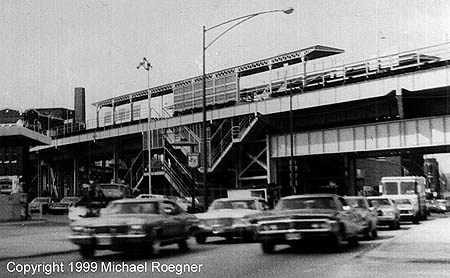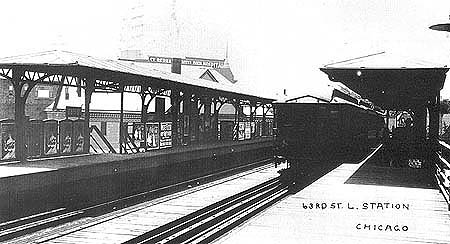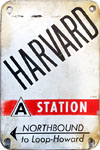|
History:

A street-level view
of the platform shows the once vibrant 63rd Street
commercial district. For a larger view, click
here.
(Photo from the Richard E. Buike
Collection)
|
The Harvard station opened November 3, 1906. The station
was simple by 1906 standards, but the platform contained
what would now be considered quite elegant: decorative
latticework, porcelain enamel wood-framed station signs and
wooden advertisement cases (reproductions of which can be
seen at the Quincy/Wells
loop station). The station house was a mezzanine level
facility beneath the tracks on the south side of the street.
When the station opened in 1906, it was named for 63rd
Street. By 1909, its name had already changed.
The short Normal Park branch, less than a mile long and
opened in 1907, departed from the Englewood
branch west of Harvard station at Stewart Junction. From
1907 to 1949, Normal Park cars were coupled to and from
Englewood trains at Harvard station for the trip north and
to return to the branch. This practice continued until 1949.
On August 1 of that year, the
CTA initiated their
North-South service revision and turned the Normal Park branch into a shuttle operation. A single train of one or
two wood cars usually worked the branch back and forth
between 69th and Harvard stations.
Transferring to Normal Park trains at Harvard required going
down from the outbound platform to the mezzanine and back up
the other side, as Normal Park trains loaded and unloaded
from the inbound platform. This continued until the Normal Park branch was eliminated in January 1954.
The station had survived numerous service revisions, but
it was closed in the service purge of February 9, 1992 and
demolished during the Green Line reconstruction of
1994-1996. The CTA was considering constructing a new station complex where
they'd demolished the old one;
then-CTA President
Robert Belcaster had hoped to tap a special fund earmarked
for projects that reduce air pollution to create a large new
63rd Street facility, including a park-n-ride lot, that
would've connected to the 63rd Dan Ryan station and created a large transit
center. Unfortunately, this never came to be (and as a
result, there is a mile and half between stations on the
Englewood branch).
|







